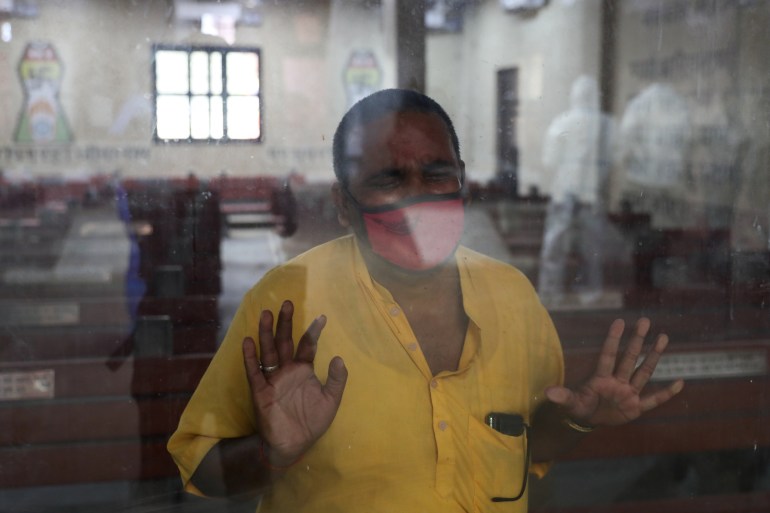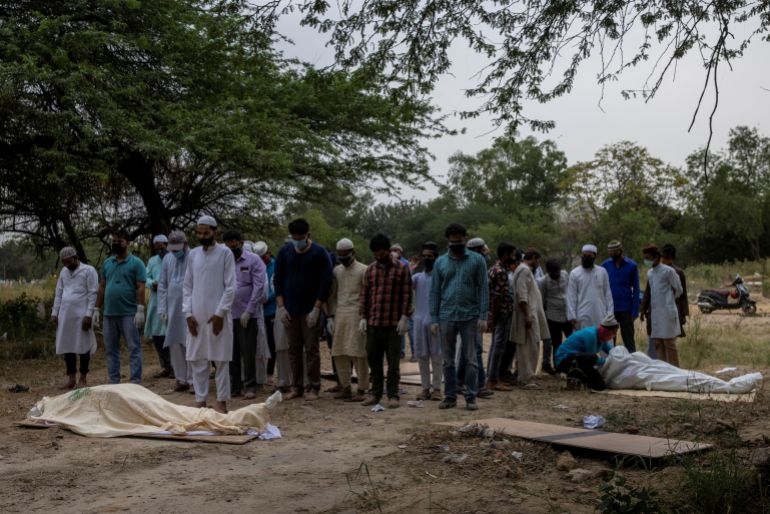Non-stop cremations cast doubt on India’s counting of COVID dead
Several major cities are reporting far larger numbers of cremations and burials under coronavirus protocols than official death tolls.

Gas and firewood furnaces at a crematorium in the western Indian state of Gujarat have been running so long without a break during the COVID-19 pandemic that metal parts have begun to melt.
“We are working around the clock at 100 percent capacity to cremate bodies on time,” Kamlesh Sailor, the president of the trust that runs the crematorium in the diamond-polishing city of Surat, told the Reuters news agency.
Keep reading
list of 4 itemsIndia, Pakistan held secret talks on Kashmir in January: Reuters
Portion of India’s historic Khuda Bakhsh library faces demolition
The high cost of India’s cheap garment exports
And with hospitals full and oxygen and medicines in short supply in an already creaky health system, several big cities are reporting far larger numbers of cremations and burials under coronavirus protocols than official COVID-19 death tolls, according to crematorium and cemetery workers, media and a review of government data.
India’s daily COVID-19 cases retreated from record levels on Tuesday but stayed above the 200,000 mark for a sixth-straight day, with cases increasing by 259,170 over the last 24 hours. Deaths rose by a record 1,761, health ministry data showed.
Officially, almost 180,000 Indians have died from coronavirus, 15,000 of them this month, although some believe the real number may be higher.
Indian social media and newspaper reports have been flooded with horrifying images of row upon row of burning pyres and crematoriums unable to cope.
‘Haven’t seen so many dead bodies’
In the western state of Gujarat, many crematoriums in Surat, Rajkot, Jamnagar and Ahmedabad are operating around the clock with three to four times more bodies than normal.

In the diamond hub of Surat, Gujarat’s second-largest city, Sailor’s Kurukshetra crematorium and a second crematorium known as Umra have cremated more than 100 bodies a day under COVID-19 protocols over the last week, far in excess of the city’s official daily coronavirus death toll of approximately 25, according to interviews with workers.
Prashant Kabrawala, a trustee of Narayan Trust, which manages a third city crematorium called Ashwinikumar, declined to provide the number of bodies received under the virus’ protocols but said cremations there had tripled in recent weeks.
“I have been regularly going to the crematorium since 1987, and been involved in its day-to-day functioning since 2005, but I haven’t seen so many dead bodies coming for cremation in all these years,” even during an outbreak of the bubonic plague in 1994 and floods in 2006.
The iron frames inside another in Surat melted because there was no time to let the furnaces cool.
“Until last month we were cremating 20-odd bodies per day… But since the beginning of April we have been handling over 80 bodies every day,” said a local official at the Ramnath Ghela Crematorium in the city.
Last week, Sandesh, a Gujarati newspaper, counted 63 bodies leaving a single COVID-19-only hospital for burial in the state’s largest city, Ahmedabad, on a day where government data showed 20 coronavirus deaths.
The chimney of one electric furnace in Ahmedabad cracked and collapsed after being in constant use for up to 20 hours every day for the past two weeks.
With waiting times of up to eight hours, Rajkot has set up a dedicated 24/7 control room to manage the flow in the city’s four crematoriums.
Government spokesmen in Gujarat did not respond to requests for comment.

Bring your own wood
In Lucknow, the capital of the populous northern state of Uttar Pradesh, data from the largest coronavirus-only crematorium, Baikunth Dham, shows double the number of bodies arriving on six different days in April than government data on COVID-19 deaths for the entire city.
At two crematoriums in Lucknow, relatives were given numbered tokens and made to wait for up to 12 hours. One started burning bodies in an adjacent park, an official told AFP news agency.
Rohit Singh, whose father died from COVID-19, said crematorium officials were charging around 7,000 rupees ($100) – almost 20 times the normal rate.
Some crematoriums in Lucknow ran out of wood and asked people to bring it themselves. Viral photos on social media showed electric rickshaws laden down with logs.
In Ghaziabad outside New Delhi, television pictures showed bodies wrapped in shrouds lined up on biers on the pavement with weeping relatives waiting for their slot.
The ultimate place for Hindus to be cremated is Varanasi, the ancient city where since time immemorial bodies have been burned on the banks of the river Ganges.
Belbhadra, who works at one of the famous ghats there, told AFP that they were cremating at least 200 suspected coronavirus victims per day.
The usual time to get to the ghat – a riverside embankment for cremations – from the main road via narrow lanes was usually three or four minutes, a resident said.
“Now it takes around 20 minutes. that’s how crowded the lanes are with people waiting to cremate the dead,” he said.
The figures from Lucknow do not take into account a second COVID-19-only crematorium in the city or burials in the Muslim community that makes up a quarter of the city’s population.
Crematorium head Azad, who goes by only one name, said the number of cremations under COVID-19 protocols had risen five-fold in recent weeks.
“We are working day and night,” he said. “The incinerators are running full time but still many people have to wait with the bodies for the last rites.”
A spokesman for the Uttar Pradesh government did not respond to a request for comment.
‘I will run out of space in 3-4 days’
A summer storm is buffeting New Delhi as Mohammed Shamim wearily pauses to glance at yet another ambulance arriving with a coronavirus victim to bury, just minutes after the last.
The gravedigger’s grim workload, like those of others around India, has grown dramatically in the past few weeks in a brutal second wave that has caught authorities badly off guard.

When AFP visited the Jadid Qabristan Ahle cemetery in the Indian capital – which is now in a week-long lockdown – on Friday, 11 bodies arrived within three hours.
By sunset, 20 bodies were in the ground. This compares to some days in December and January, when his earthmoving machine stayed idle and when many thought the pandemic was over.
“Now, it looks like the virus has legs,” Shamim, 38, a gravedigger like his father and grandfather, told AFP. “At this rate, I will run out of space in three or four days.”
Around the graveyard, white body bags or coffins made out of cheap wood are carried around by people in blue or yellow protective suits and lowered into graves.
Small groups of men, some in skullcaps, look solemnly at the ground as the imam, struggling to be heard as dust laced with rain swirls around, recites final prayers.
Sobbing women watch from their closed car windows next to the flashing lights of an ambulance as a yellow digger fills up the graves with the dry brown and grey soil.
“Two days ago someone came to me and said he needs to start preparing for his mother because doctors had given up on her,” Shamim said.
“It’s unreal. I never thought I’d see the day where I’d have a request for starting the funeral formalities of a living person.”
Elsewhere, India Today magazine reported two crematoriums in Bhopal, the capital of the central state of Madhya Pradesh, 187 bodies were cremated following COVID-19 protocols in four days this month, while the official coronavirus death toll stood at five.
TV grab of a cremation ground #Bhopal. Shocking n scary. Help us God! 🙏🙏 pic.twitter.com/7vEw9CgJiw
— Vinod Sharma (@VinodSharmaView) April 19, 2021
‘Data denial’
India is not the only country to have its coronavirus statistics questioned. But the testimony of workers and a growing body of academic literature suggest deaths in India are being under-reported compared with other countries.
Experts say reliable data is at the heart of any government response to the pandemic, without which planning for hospital vacancies, oxygen and medicine becomes difficult.
Bhramar Mukherjee, a professor of biostatistics and epidemiology at the University of Michigan, said many parts of India were in “data denial”.
“Everything is so muddy,” she said. “It feels like nobody understands the situation very clearly and that’s very irksome.”
Mukherjee’s research of India’s first wave concludes that there were 11 times more infections than were reported, in line with estimates from studies in other countries. There were also between two and five times as many deaths than were reported, far in excess of global averages.
The Lancet medical journal noted last year that four Indian states making up 65 percent of COVID-19 fatalities nationally each registered 100 percent of their coronavirus deaths.
But fewer than a quarter of deaths in India are medically certified, particularly in rural areas, meaning the true COVID-19 death rate in many of India’s 24 other states may never be known.
Government officials say the mismatch in death tallies may be caused by several factors, including over-caution.
A senior state health official said the increase in numbers of cremations had been due to bodies being cremated using COVID-19 protocols “even if there is 0.1 percent probability of the person being positive”.
“In many cases, patients come to hospital in an extremely critical condition and die before they are tested and there are instances where patients are brought dead to hospital, and we do not know if they are positive or not,” the official said.